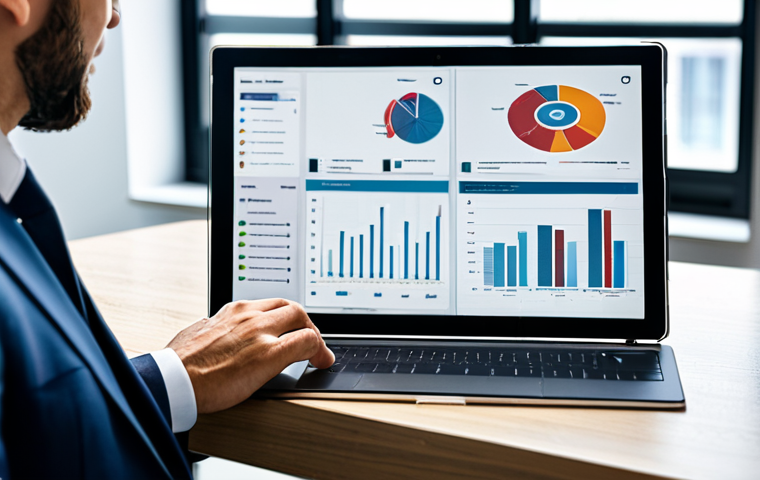It can feel like a mountain to climb, navigating the intricate world of property management, especially when you’re aiming for a professional certification.
I remember the sheer volume of material, from tenancy laws to financial accounting, and honestly, the thought of structuring a study routine felt just as daunting as the exams themselves.
But through trial and error, I discovered a rhythm that not only made the process manageable but genuinely enjoyable. It wasn’t about rigid timetables; it was about integrating learning into my daily life, finding little pockets of time, and truly understanding the *why* behind each regulation.
The property landscape is rapidly evolving, with smart home technology becoming standard and sustainability a major focus, so staying current isn’t just about passing tests, but about future-proofing your expertise.
Forget rote memorization; think practical application, because that’s what truly sets you apart in this competitive field. This initial journey, from aspiring manager to certified professional, taught me invaluable lessons about resilience and effective learning.
It’s a career path that truly blends legal acumen with a human touch, dealing with everything from complex lease agreements to ensuring a safe, comfortable living environment for residents.
The rise of proptech and new rental models means the demands on property managers are constantly shifting, requiring adaptability and a forward-thinking approach.
It’s not just about collecting rent anymore; it’s about community building and leveraging technology to enhance operational efficiency. Let’s dive deeper into it below.
Navigating the Evolving Legal Landscape in Property Management

Stepping into property management, I quickly realized that understanding the law wasn’t just a recommendation; it was the bedrock of everything. I remember a particularly challenging situation early in my career, dealing with a tenant who consistently violated their lease terms. It wasn’t enough to just know the rules; I had to understand the nuances of local housing codes, fair housing laws, and eviction procedures down to the letter. Every state, every county even, seems to have its own unique twist on tenant-landlord regulations, and staying on top of these changes feels like a constant high-stakes game of legal whack-a-mole. It’s not just about what you can do, but what you should do, always balancing legal compliance with ethical practice and tenant relations. I’ve learned that a proactive approach, like ensuring all leases are meticulously drafted and regularly reviewed, saves endless headaches down the line. Overlooking a small detail in a lease agreement or misinterpreting a local ordinance can lead to costly legal battles and reputational damage. This is where continuous education truly pays off, not just for certifications but for daily operational resilience.
1. Deciphering Local and Federal Housing Regulations
My journey through the labyrinth of housing regulations was an eye-opener. It wasn’t just the sheer volume, but the way they intertwined. I vividly recall grappling with the Americans with Disabilities Act (ADA) and its implications for property modifications, or the intricacies of the Fair Housing Act and its protected classes. These aren’t abstract concepts from a textbook; they directly impact how you advertise, screen tenants, and manage properties day-to-day. For instance, understanding reasonable accommodations for service animals versus pet policies is a common trap many new managers fall into. I once encountered a situation where a potential tenant, who legitimately required a service animal, was nearly denied due to a blanket “no pets” policy. Correcting that quickly and educating my team was crucial. It solidified my belief that true expertise comes from applying these laws in real-world scenarios, learning from every interaction, and always prioritizing compliance to protect both the property owner and the residents.
2. Lease Agreements: Your First Line of Defense
I’ve come to view lease agreements not just as legal documents, but as comprehensive blueprints for a successful landlord-tenant relationship. The devil, as they say, is in the details, and I’ve seen firsthand how vague clauses or missing stipulations can lead to massive disputes. I once inherited a property with an older lease that was incredibly sparse on details regarding tenant responsibilities for minor repairs. Predictably, this led to arguments over who was responsible for a leaking faucet or a clogged drain. It was a painful lesson in the importance of specificity. Now, my leases are robust, covering everything from maintenance responsibilities and noise policies to pet rules and early termination clauses. I even include clear sections on digital communication expectations. My advice? Don’t just copy a generic template. Tailor your lease to your specific property, local laws, and even common issues you’ve encountered. It’s your primary tool for setting expectations and mitigating future conflicts.
Mastering the Art of Tenant Relations and Communication
Honestly, when I first started, I thought property management was mostly about buildings and budgets. Boy, was I wrong! It’s overwhelmingly about people. I’ve spent countless hours mediating disputes between neighbors, helping tenants navigate unexpected life changes, and even just lending an ear when someone needed to vent. It’s a deeply human role, and the ability to communicate effectively, often in high-stress situations, is an absolute superpower. I’ve learned that a proactive, empathetic approach can defuse a potential crisis before it even ignites. Ignoring a tenant’s concern, no matter how small it seems to you, can quickly escalate into a major issue. My personal philosophy evolved to treat every tenant interaction as an opportunity to build trust and demonstrate professionalism. It’s about being firm when necessary, but always fair and understanding. This isn’t just fluffy talk; positive tenant relationships lead to lower vacancy rates, fewer damages, and a much more enjoyable experience for everyone involved.
1. Building Trust Through Transparent Engagement
I distinctly remember a resident who was initially very skeptical of property managers, having had negative experiences in the past. It took consistent effort, clear communication, and follow-through on every promise, big or small, to earn their trust. We implemented a new online portal for maintenance requests and rent payments, which streamlined things immensely, but more importantly, we made sure to provide timely updates on every request. Even if a repair was delayed, a quick message explaining why and when they could expect it made all the difference. I found that transparency about rent increases, policy changes, and even unexpected maintenance issues fostered a sense of partnership rather than an adversarial dynamic. It’s about being upfront and honest, even when the news isn’t great. That’s how you build a reputation for reliability and integrity in the community.
2. Effective Conflict Resolution and Mediation Skills
Conflict is inevitable in any human interaction, and property management is no exception. I’ve mediated disputes ranging from noisy neighbors to parking disagreements and even issues regarding shared amenities. My approach has always been to listen, truly listen, to both sides without judgment, identify the core issue, and then facilitate a solution that respects everyone’s rights while upholding the lease terms. I recall a particularly tense situation between two residents over shared storage space. Instead of immediately dictating a solution, I sat them down, allowed them to voice their concerns, and guided them towards a compromise that worked for both. It wasn’t about being a judge; it was about being a facilitator. These experiences taught me patience, active listening, and the importance of remaining impartial. Often, a calm, neutral third party is all that’s needed to de-escalate a heated situation and find common ground.
Leveraging Proptech for Enhanced Operational Efficiency
If you’re still managing properties with spreadsheets and physical filing cabinets, you’re not just inefficient; you’re leaving money on the table and risking critical errors. My journey into property management truly transformed when I started embracing technology. I used to spend hours manually reconciling rent payments and chasing down maintenance requests via phone calls. The sheer amount of paperwork was overwhelming. Investing in robust property management software wasn’t just a luxury; it became a necessity, fundamentally changing how I operated. It felt like shedding a heavy burden, freeing up so much time to focus on strategic initiatives and tenant relations, rather than getting bogged down in administrative minutiae. The landscape of proptech is evolving at an incredible pace, and staying ahead of the curve means better service for tenants, happier owners, and a more streamlined, profitable operation for me.
1. Streamlining Workflows with Integrated Software Solutions
I’ve experimented with several property management software platforms over the years, from basic accounting tools to comprehensive enterprise solutions. The key, I’ve learned, is finding a system that integrates everything: tenant screening, online rent collection, maintenance request tracking, financial reporting, and even communication portals. My current system allows tenants to submit requests online, complete with photos, which immediately creates a work order for my maintenance team. Owners can log in and view financial reports in real-time. This level of automation drastically cuts down on manual data entry errors and provides immediate insights into the property’s performance. It’s not just about saving time; it’s about providing a professional, seamless experience for everyone involved. I remember the relief when I could finally ditch my multiple spreadsheets and have all data consolidated in one accessible, cloud-based platform. The efficiency gains were immediate and profound.
2. Embracing Smart Home Technology for Modern Living
The rise of smart home technology has been a game-changer, not just for tenant convenience but for property management efficiency and even security. I initially approached smart locks and thermostats with a bit of skepticism, wondering if they were just fads. However, after implementing them in a few units, I saw the undeniable benefits. Remote access for maintenance visits, energy savings for both tenants and owners through smart thermostats, and enhanced security features became clear differentiators. I’ve also explored smart leak detection systems, which can alert me to potential water damage before it becomes a catastrophic issue, saving thousands in repairs. It adds a layer of modern appeal that attracts tech-savvy tenants and subtly reduces operational costs. It’s about creating properties that aren’t just places to live, but smart, responsive homes that enhance the resident experience.
| Feature | Traditional Management | Tech-Enabled Management |
|---|---|---|
| Rent Collection | Manual checks, bank deposits, late payment chasing. | Automated online payments, auto-reminders, detailed transaction logs. |
| Maintenance Requests | Phone calls, voicemails, handwritten notes, delayed response. | Online portal, photo uploads, automated work orders, real-time updates. |
| Tenant Screening | Manual background checks, paper applications, slow turnaround. | Integrated online applications, instant background/credit checks, fraud detection. |
| Financial Reporting | Manual ledger entries, spreadsheet errors, monthly reconciliation. | Automated expense tracking, real-time financial dashboards, owner portals. |
| Communication | Phone calls, emails, scattered messages. | Centralized communication hub, broadcast messages, tenant portal. |
Financial Acumen: Beyond the Ledger and Towards Profitability
Early in my career, I admit, the financial side of property management felt like a daunting labyrinth of numbers. Budgets, balance sheets, income statements, cash flow – it was a lot to take in. But I quickly realized that true expertise in this field isn’t just about collecting rent; it’s about optimizing the financial health of every property. I’ve personally seen properties transform from struggling assets to lucrative investments simply by implementing smarter financial strategies. It’s not just about cutting costs, but about strategic investment, understanding market trends, and maximizing revenue opportunities. My approach shifted from reactive bookkeeping to proactive financial planning, and that’s when I truly started to feel like a value-adding partner to property owners. It’s a dynamic interplay of risk assessment, market analysis, and meticulous record-keeping that genuinely excites me now.
1. Strategic Budgeting and Expense Management
I learned the hard way that a budget isn’t just a static document; it’s a living, breathing financial roadmap. My first attempt at a property budget was, shall we say, aspirational rather than realistic. I overlooked hidden costs and underestimated maintenance expenses. That initial misstep taught me the critical importance of meticulous detail and realistic forecasting. Now, I dive deep into historical data, anticipate seasonal fluctuations, and build in contingency funds for unexpected repairs. I also constantly look for ways to optimize vendor contracts, explore energy-saving upgrades, and negotiate better insurance rates. It’s about finding that sweet spot where you provide top-notch service without breaking the bank for the owner. I once managed to reduce a property’s annual utility bill by 15% just by implementing a comprehensive energy audit and making a few strategic upgrades – a win for both the environment and the owner’s bottom line.
2. Maximizing Revenue and Understanding Market Dynamics
It’s not enough to just fill vacancies; it’s about filling them at the right price and with the right tenants. I vividly remember agonizing over setting rental prices for new units. Too high, and they sit vacant; too low, and you’re leaving money on the table. My breakthrough came when I started leveraging real-time market data and understanding demand-supply dynamics. I now conduct thorough market analyses before every lease renewal or new listing, looking at comparable properties, absorption rates, and economic indicators. I also consider value-added services or amenities that could justify a slightly higher rent, like enhanced security or community events. I’ve successfully implemented dynamic pricing models for short-term rentals in certain portfolios, adjusting rates based on seasonality and local events, which significantly boosted occupancy and revenue. This proactive approach to revenue generation is what truly elevates a property manager from a caretaker to a strategic asset manager.
Crisis Management and Risk Mitigation: Preparing for the Unexpected
No matter how well you plan, unexpected events will inevitably happen in property management. I’ve faced everything from burst pipes in the middle of winter to dealing with the aftermath of natural disasters, and even navigating complex legal disputes that seemed to appear out of nowhere. Early in my career, I felt overwhelmed by these sudden challenges. I remember a massive power outage that affected multiple buildings, leaving tenants without heat during a cold snap. It was chaotic. But through these experiences, I’ve developed a robust framework for crisis management and, more importantly, learned the invaluable lesson that proactive risk mitigation is far superior to reactive damage control. It’s about having a plan, a network of reliable contacts, and the mental fortitude to stay calm when everything around you seems to be falling apart. My goal now is always to anticipate potential problems and put safeguards in place, rather than just waiting for things to go wrong.
1. Developing Robust Emergency Response Protocols
I’ve learned that having a clear, well-communicated emergency plan is non-negotiable. I recall a fire alarm malfunction that caused a mass evacuation and a lot of confusion. Afterward, I meticulously reviewed and updated our emergency protocols, making sure every tenant received clear instructions on what to do in various scenarios – fire, flood, power outage, or even a medical emergency. This included clear evacuation routes, designated meeting points, and emergency contact numbers. We also established a 24/7 emergency line and made sure our maintenance team was always on call and equipped to handle urgent situations. Regular drills, even mock ones, ensure that both tenants and staff know exactly what to do when seconds count. It gives me peace of mind knowing that, should something happen, we have a clear, practiced response in place, minimizing panic and potential harm.
2. Proactive Measures for Property Security and Safety
Beyond emergencies, daily security and safety are paramount. I’ve always been incredibly vigilant about maintaining safe environments for residents. This means regular inspections for potential hazards, ensuring adequate lighting in common areas, and keeping up-to-date with fire safety codes. I once discovered a tripping hazard in a dimly lit stairwell during a routine inspection that could have led to a serious injury. Fixing it immediately, and then establishing a regular lighting check, became a priority. I’ve also invested in advanced surveillance systems and access control technologies where appropriate, not just for deterring crime but also for providing residents with a sense of security. It’s about creating a living space where people feel genuinely safe and protected, and that often involves thinking like a potential intruder or an accident waiting to happen, then eliminating those risks.
Cultivating Sustainable Practices and Community Building
When I first entered property management, sustainability wasn’t the buzzword it is today. It was often seen as an expensive add-on, not a core strategy. But I’ve personally witnessed a significant shift, driven by both environmental consciousness and the undeniable long-term financial benefits. Implementing green initiatives isn’t just about saving the planet; it’s about saving money for owners through reduced utility costs and attracting a growing demographic of environmentally-conscious tenants. Beyond that, I’ve come to appreciate how much a vibrant, engaged community contributes to the overall success and appeal of a property. It’s not just about managing buildings; it’s about fostering an environment where people feel connected and proud to call home. This dual focus on sustainability and community has become a cornerstone of my approach, transforming properties into thriving, desirable places.
1. Implementing Eco-Friendly Property Upgrades
I remember feeling overwhelmed by the initial cost of sustainable upgrades, but my experience taught me that the return on investment can be substantial. I spearheaded a project to convert an older building’s lighting to LED, which seemed like a small change but dramatically cut down on electricity consumption. Then we moved on to low-flow fixtures in bathrooms and kitchens, which reduced water usage significantly. Recycling programs, composting initiatives, and even educating tenants on energy-saving habits became part of our routine. I also explored partnerships with local solar panel installers for a larger-scale project, which initially seemed daunting but ultimately provided a compelling long-term benefit for the owner and attracted environmentally-conscious tenants. It’s about making incremental changes that cumulatively make a big difference, showing both owners and residents that you’re committed to a greener future.
2. Fostering a Thriving Resident Community
A property is more than just walls and a roof; it’s a collection of individuals who share a living space. My most rewarding experiences have often come from seeing residents connect and form a genuine community. I started organizing simple events – a summer barbecue, a holiday potluck, or even just a monthly coffee hour in the common room. These informal gatherings created opportunities for neighbors to meet, leading to stronger bonds and a more harmonious living environment. I’ve also facilitated the creation of resident-led initiatives, like a community garden or a book club, which empowered tenants to take ownership and contribute to their shared space. A strong community reduces turnover, improves satisfaction, and even helps deter crime, as neighbors look out for one another. It’s an intangible asset that dramatically enhances the value and appeal of any property, making it truly feel like home.
Continuous Learning and Adapting to Industry Evolution
The property management landscape is anything but stagnant. When I first got my certification, I thought, “Okay, done that, got the T-shirt.” How naive I was! The industry is a living, breathing entity, constantly evolving with new technologies, changing regulations, and shifting tenant expectations. I’ve come to realize that true expertise isn’t a destination; it’s a continuous journey of learning and adaptation. From the emergence of AI in property tech to evolving concepts of flexible living and co-working spaces within residential properties, there’s always something new to learn, something to master. This constant flux, while challenging, is also what keeps the job exciting and ensures that complacency never sets in. My professional growth has been directly tied to my willingness to step outside my comfort zone and actively seek out new knowledge and skills, understanding that stagnation is the quickest path to irrelevance.
1. Staying Current with Emerging Technologies and Trends
I make it a point to regularly attend industry webinars, subscribe to leading proptech journals, and participate in online forums. I remember when virtual reality tours first started gaining traction; I was initially hesitant, but I saw how they could revolutionize property showings, especially for out-of-town prospects. So, I invested time in understanding the technology and eventually integrated it into our leasing process. Similarly, I’m now closely watching the development of blockchain for property transactions and advanced data analytics for predictive maintenance. It’s not about jumping on every bandwagon, but about critically assessing how new trends can genuinely improve efficiency, tenant satisfaction, or profitability. My goal is always to be an early adopter of valuable innovations, not just a follower. It’s about future-proofing my skills and the properties I manage.
2. The Value of Professional Networking and Mentorship
I truly believe that some of the most valuable lessons I’ve learned haven’t come from textbooks but from my peers and mentors. I vividly recall struggling with a particularly complex commercial lease negotiation, feeling completely out of my depth. Reaching out to a senior property manager I knew through a professional association provided me with invaluable guidance and a fresh perspective that ultimately helped me close the deal successfully. Networking isn’t just about collecting business cards; it’s about building genuine relationships with people who share your challenges and successes. I regularly participate in local real estate meetups and national conferences. These interactions provide opportunities to share best practices, discuss industry challenges, and even uncover new business opportunities. Having a strong professional network and a few trusted mentors has been absolutely crucial for my career trajectory, offering support, advice, and a sense of belonging in a demanding profession.
Closing Thoughts
Reflecting on my journey in property management, it’s clear this profession is far more than just bricks and mortar; it’s a dynamic tapestry woven with legal intricacies, human connections, technological advancements, and financial stewardship. Every challenge has been a lesson, every success a testament to persistent learning and adaptation. What truly sets a great property manager apart, I believe, is not just competence, but a genuine commitment to creating thriving communities and sustainable investments. It’s a demanding but incredibly rewarding path, constantly pushing you to evolve and innovate. So, whether you’re just starting out or looking to refine your approach, embrace the continuous learning, prioritize relationships, and leverage the tools at your disposal – your properties, and your tenants, will thank you for it.
Useful Information to Know
1. Understand Your Local Ordinances Inside Out: Beyond federal laws, state and local housing codes vary widely. A deep dive into your specific city or county’s regulations on evictions, rent control, tenant rights, and even pet policies can save you immense legal headaches and costs. Local real estate associations are often great resources.
2. Never Underestimate the Power of Clear Communication: Most tenant disputes or misunderstandings can be traced back to a lack of clarity. Be proactive with updates, articulate expectations clearly in lease agreements, and always respond to inquiries promptly and professionally, even if it’s just to say you’re looking into something.
3. Invest in Quality Property Management Software: Seriously, don’t skimp here. An integrated platform for rent collection, maintenance requests, tenant screening, and financial reporting will not only save countless hours but also minimize errors and provide invaluable data for strategic decision-making. Cloud-based solutions offer accessibility from anywhere.
4. Build a Network of Reliable Contractors and Vendors: When a pipe bursts at 2 AM or an HVAC system fails in a heatwave, you need trusted professionals who can respond quickly and efficiently. Cultivate relationships with plumbers, electricians, landscapers, and general contractors before you need them, and always get references and insurance details.
5. Prioritize Preventative Maintenance: An ounce of prevention is worth a pound of cure. Regular inspections, timely repairs of minor issues, and seasonal maintenance checks (e.g., HVAC servicing, gutter cleaning) can prevent costly major breakdowns, extend the lifespan of property assets, and keep tenants happy.
Key Takeaways
Successful property management is a multifaceted discipline that demands continuous learning, empathetic communication, and strategic financial acumen. It’s about navigating complex legal frameworks, leveraging technology for efficiency, fostering strong tenant relationships, and preparing for the unexpected. Ultimately, it’s a commitment to building and maintaining valuable assets while creating desirable living environments, ensuring long-term profitability and resident satisfaction through a proactive, human-centered approach.
Frequently Asked Questions (FAQ) 📖
Q: How do you tackle the sheer volume of material for property management certification without getting overwhelmed?
A: Honestly, I felt that deep dread just looking at the syllabus – tenancy laws, accounting, maintenance protocols… it felt like an insurmountable pile. My trick?
It wasn’t about chaining myself to a desk for eight hours straight; that just led to burnout. I learned to integrate learning into my daily life. Twenty minutes on the train, ten minutes during a lunch break, an hour after dinner.
It’s about finding those little nuggets of time. More importantly, I stopped trying to just memorize facts. I focused on understanding the why behind each regulation.
Why is this disclosure required? Why is this accounting practice essential? When you grasp the underlying principle, the specifics tend to click into place.
Suddenly, it’s not just a dry rule; it’s a practical safeguard for both owner and tenant. Those “aha!” moments, born from real-world examples I’d either experienced or imagined, made the information stick.
It became less about passing a test and more about genuinely preparing myself for the job.
Q: With proptech and new rental models emerging, what’s the biggest shift you’ve seen in the day-to-day demands on property managers?
A: It’s no longer just about collecting rent and fixing leaky faucets, although those are still foundational! The biggest shift I’ve witnessed, hands down, is the move towards proactive community building and leveraging technology to enhance the resident experience, not just operational efficiency.
Gone are the days when a manager was solely a reactive problem-solver. Now, we’re expected to be tech-savvy, using smart home integrations for energy management, implementing resident portals for seamless communication, and even curating events that foster a sense of belonging among tenants.
I’ve seen firsthand how adopting a good proptech platform can free up hours previously spent on manual tasks, allowing us to focus on what truly differentiates us: creating a desirable living environment.
This means being a bit of a sociologist, a tech troubleshooter, and a relationship builder, all while staying on top of the usual legalities. It’s a complete paradigm shift, and honestly, it’s made the job far more engaging.
Q: You mentioned “future-proofing your expertise” and practical application over rote memorization. Can you elaborate on why that’s so critical today?
A: Think about it – when a pipe bursts at 2 AM or you’re mediating a complex neighbor dispute, no textbook prepares you for the sheer human element and the immediate, practical decisions you need to make.
Rote memorization will get you through an exam, sure, but it won’t teach you the quick thinking, the emotional intelligence, or the adaptability needed in real-time.
Future-proofing my expertise, for me, means constantly learning from every challenging situation, every new piece of technology, and every shift in tenant expectations.
It’s about being able to pivot when a new sustainability regulation comes into play or when a smart home system goes haywire. It’s the difference between knowing what the law says and knowing how to apply it with empathy and efficiency in a high-pressure situation.
That practical, on-the-ground understanding, the ability to anticipate issues and innovate solutions – that’s what genuinely builds trust with owners and residents, and that’s what truly sets you apart in this competitive, ever-evolving field.
📚 References
Wikipedia Encyclopedia
구글 검색 결과
구글 검색 결과
구글 검색 결과
구글 검색 결과
구글 검색 결과






